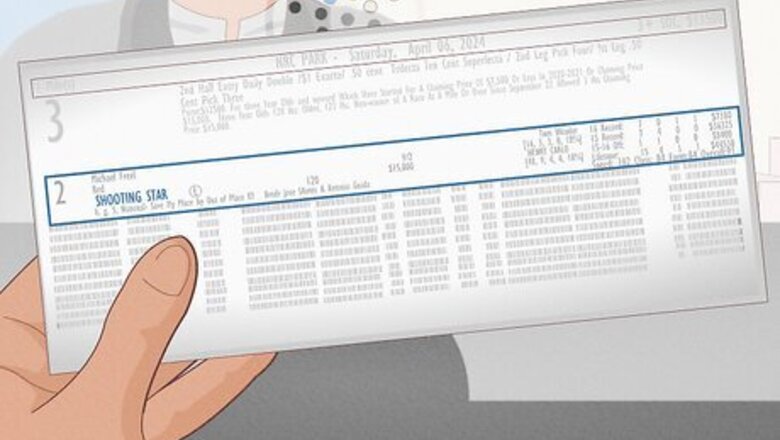
views
Placing a Wager

Decide which horse or horses you want to bet on. Start by reading the racing form, which will give you statistics about each horse, trainer, and jockey. Pay attention to the following factors when choosing a winning horse: Trainer stats: Pay attention to whether a trainer has been winning races, prize money, and whether they’ve had success in specific areas, such as certain types of horses or areas of the sport. Jockey stats: Look for jockeys that consistently place in first, second, or third place. Look at the jockey’s history with the horse they will be riding and whether that pairing has consistently finished in the top three spots together. Horse odds: Betting on the favorite horses (who will have the lowest odds) gives you the best chance of return on your money, although it may be a small return. Surface type: Read through each horse’s past performance on different surface types. If a horse has only won races on dirt tracks and you’re at an all-weather course, you may want to consider another contender. Gate position: Look at stats related to the race distances at each track and if there is a gate advantage depending on whether the horse is starting on an inside or outside lane. Speed figures: Look for how quickly a horse can move from one point to another to assess its overall ability or look for races in which only one horse has a solid early speed. Paddock behavior: Before they race, horses are walked through a part of the track called the “paddock.” Observe each horse’s behavior—go for horses that seem alert but calm, and avoid any that seem jittery, nervous, or have visible sweat stains. If you’re going to the racetrack for fun and aren’t too worried about winning, you can simply choose a horse that’s wearing your favorite number or color, has features you like, or has a cool name!

Place your wager with the track’s official teller. Some race tracks offer machine tellers as well as human tellers. If you’re a beginner to horse betting, start with the human teller to make sure your bet is placed correctly. Have your money and your decided bets ready, as bettors have limited time to place their wagers, and you don’t want to hold up the line. Follow these steps to place your bets: State the name of the racetrack and the race number you’re betting. State the dollar amount of your bet and the type of wager you’re placing. State the program number of the horse or horses you’re betting on. Hand the teller your money, check that your ticket information is accurate, and keep your ticket in a safe place so you can use it to claim your money if you win the horse race. For example “Arlington Park, race nine, $2 to win on horse #3.”
Most Popular Types of Wagers

Straight bets Straight bets or wagers include win, place, and show. As a beginner, placing a straight bet with small stakes is a good place to start. The win is the most popular and straightforward bet, and it pays the most if won as it’s difficult to get right. Win: Your horse must come in first place for the bet to pay off. Place: Your horse must finish in first or second place for the bet to pay off. Show: Your horse must finish in first, second, or third place for the bet to pay off. Across the Board: This bet combines win, place, and show wagers. If you use this bet on a horse, you are betting that it will win both place and show. If the horse comes in first place, you’ll collect on all three bets. If it places second, you collect place and show; if it's third, you collect show.

Exotic bets The most common types of exotic bets include the exacta, trifecta, and superfecta. Exotic wagers are popular among horse bettors because these bets allow them to put money on horses that are unlikely to win without needing them to win. For example, if you think a horse with bad odds has a better chance of winning than its odds suggest, you could get a high payout if you include that horse in an exotic wager. Exacta: Bet on two horses finishing in first and second place, in that exact order. Trifecta: Bet on three horses that will finish first, second, and third place, and predict the exact order in which they will finish. Superfecta: Bet on four horses to finish in the top four runners and predict their exact placement order—this bet is nearly impossible to win but has a high payoff if successful. Box: Betting an exacta, trifecta, or superfecta box is more expensive but your bet covers all possible orders in which your chosen horses may finish. If you bet two horses in an exacta box, for example, your bet is successful as long as those two horses finish in the first two places, regardless of order. Quinella: Bet on two horses to finish in first or second place, in either order. While Quinella bets are similar to exacta box bets, but a quinella costs slightly less to wager and are made in a more advanced betting pool with a higher potential cash-out.
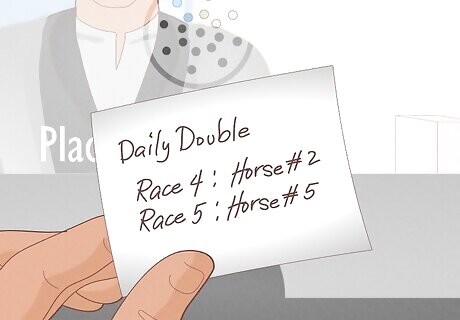
Bets for multiple races For more advanced bettors, there are several options to bet across multiple races. You can bet on which horse(s) will win two, three, four, or five consecutive races. However, your wagers for all races in a series must be placed before the first leg of the first race begins. Daily Double Pick the first place winning horse of two consecutive races. Pick 3: Pick the first place winning horse of three consecutive races. Pick 4: Pick the first place winning horse of four consecutive races. Pick 5: Pick the first place winning horse of five consecutive races. Pick 6: Pick the first place winning horse of six consecutive races. Grand Slam Pick a horse to finish in three first three places of three consecutive races. Then, select the winner of the fourth race in the sequence.
Reading a Horse Racing Form
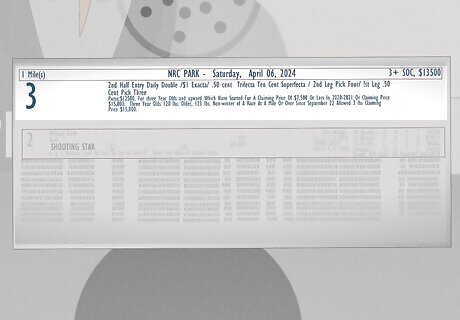
Read the header for information about the race and track. Find the race number written in large text in the upper-left corner of the form. The race number will typically be in the 1-10 range, indicating in what order the race will run day. Other information found in the form’s header includes: Track Name: Written in large, bold print above all other information in the header. Wagers: Written at the top of the form near the track name to specify which types of wagers are allowed in the race. Race Conditions & Purse: Written in about 3 lines of text below header. Includes distance, conditions, and prize money won in the race.

Find info about an individual horse directly beneath the header. This section includes information on the horse, its owner, and its jockey. The horse’s name is written in the largest font on the left-hand side of this section, along with other information such as: Program Number: A large number on the left side of the section indicates what number the horse is listed under in the program. Morning Line Odds: Written to the right of the large program number, indicating what this horse’s final odds are predicted to be after all bets are placed. Class Rating: A small number written underneath the word “Class,” indicating an estimate of the horse’s speed rating based on past performance. Trainer Information: Written directly above the horse’s name with the trainer’s name, starts, wins, places, and shows. Weight Carried: A bolded number directly to the left of the jockey’s name, which tells how much weight the horse will be carrying in the race, including the weight of the jockey and all equipment. Jockey Information: Found on the rightmost edge of the form with the jockey’s name and statistics, including the starts, wins, places, and shows they’ve had at this meet.

Study the horse’s past performance in the bottom section of the form. This section is divided into three sections, all of which include detailed and extensive information about the horse’s race history. When you have your race form in front of you, use this diagram from Equibase, the company that makes all racing forms in the U.S., as a cheat sheet. Leftmost section: Includes a column with the dates of the horse’s past races. Moving toward the right, you’ll find each race’s course conditions, age restrictions, and the horse’s final time for that race. Middle section: Lists the horse’s pace figure for each race, where the horse was at each point of call, their final finish position, the jockey’s name for that race, the weight carried by the horse, and if they ran with any medication. Rightmost section: Includes the final odds for that horse at the start time of the race (with an asterisk if they were the favorite) and short footnotes reflecting any chart comments made about the horse.
Top Strategies & Statistics in Horse Betting

Listen to the simulcast commentator for tips. Racetracks always have a simulcast commentator who is being broadcast for TV programs. These commentators, and other experts, often give important information and stats about horses, jockeys, and top tips.
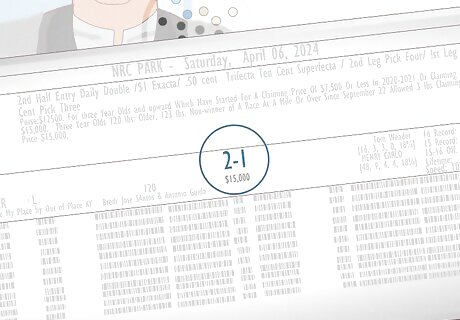
Use the morning line as a guide, not a rule. The morning line odds are the odds printed in the race program. An expert track employee decides these odds based on how they believe the betting for the race will go. The morning line is a prediction of how the public will bet the race, not who the oddsmaker thinks will actually win. While reading odds is important, it’s better to use the morning line as a rough guide rather than a rule for who is most likely to win.
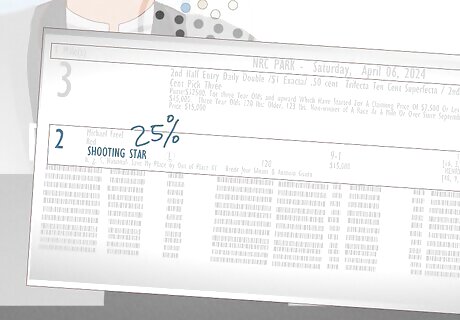
Bet on underdogs if you see a change that’ll help the horse succeed. For example, if a horse has a high speed rating but isn’t favored because they’ve been racing unsuccessfully on long-distance tracks, try betting on them on a shorter race. Or, if a horse hasn’t been ranking on soft tracks, place a wager on them once they’re on a firmer track. Since these horses aren’t favored to win, you’ll receive a lot more bang for your buck if they do. However, you have to have a lot of knowledge and insight about horses and racing for this betting strategy, so use it with caution.
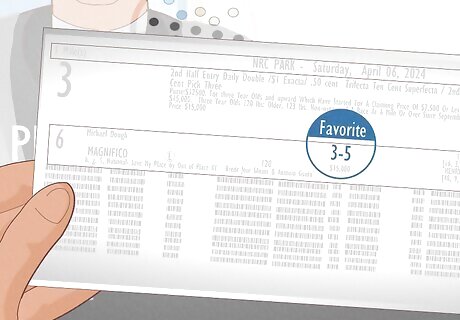
Favorite horses win about 33% of all horse races. You don’t want to always bet on favorites, as the payoffs are low, and they won't win every time. However, if you want to win despite the low payout, your best bet is to wager on a horse in the top four spots of the betting market.
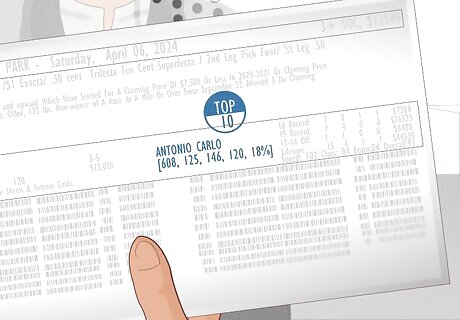
90% of races are won by jockeys in the top 10 of the rider’s standings. While most amateur horse bettors will focus on the horses’ rankings, the jockeys are just as important. Look for which jockeys have been consistently winning and holding a spot in the jockey standings. These jockeys are most likely to be riding the best horses.


















Comments
0 comment